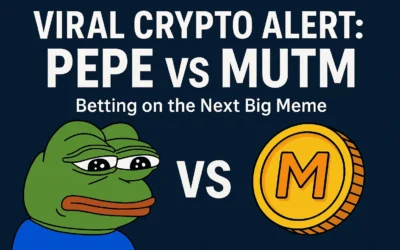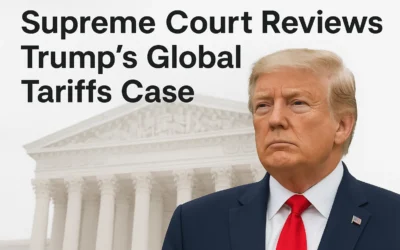1. The Global Powder Keg: Why Everyone Feels the Tension
Something feels off in today’s markets.
Gold just hit a record high — then dropped sharply.
Crypto has been crushed (especially altcoins).
The euro is sliding toward record lows against the Swiss franc.
And investors from Wall Street to Zurich whisper the same words:
“Stagflation. War. Or both.”
The world economy is stuck between weak growth and stubborn inflation — stagflation — while geopolitical tensions and debt levels keep rising.
Meanwhile, central banks can’t easily cut rates because inflation hasn’t fully gone away.
This is what fragility looks like:
- Record-high stock valuations
- Record-high corporate and sovereign debt
- Record-low liquidity
- Record dependence on “AI hype” and tech narratives
Many compare it to 1999 (dotcom) or 2008 (subprime) — only bigger.
And even the giants like BlackRock and Goldman Sachs are using option-based hedges to protect portfolios against a potential market shock.
2. What Happens in a Global Correction
Let’s be clear: no one knows when the next crash will hit. But the setup is classic:
- Too much optimism around AI and tech stocks that have no profits.
- High-yield (“junk”) debt that depends on constant liquidity.
- Stretched valuations on global equities.
- Weak safety nets in Europe and China’s slowdown adding systemic risk.
When trust disappears, markets don’t just “correct” — they repriced belief itself.
The real danger is a liquidity shock: when everyone sells at once, even “safe” assets move together.
So, what can investors do to protect themselves?
That’s where options strategies come in.
3. Options 101 — The Basics in Plain English
An option is a contract that gives you the right, but not the obligation, to buy or sell something at a specific price before a certain date.
- A Call option = the right to buy an asset.
- A Put option = the right to sell an asset.
You can use them not only to speculate, but to protect — like insurance.
4. Smart Option Strategies for Uncertain Times
Let’s look at how professionals hedge against major risks, using strategies that anyone can understand and apply (with proper education and a broker that allows options trading).
A. Protective Put — “Crash Insurance”
Think of this as insurance for your stocks.
You pay a small premium to guarantee a minimum sale price.
Example:
You own 100 shares of Apple at $180.
You buy a Put option with strike $165 that expires in 3 months.
If the stock falls to $140, you can still sell at $165.
✅ Benefit: Limited loss, unlimited upside.
❌ Cost: You pay the premium (like insurance).
Tip: Don’t buy random puts — buy them when volatility is low (they’re cheaper).
B. Put Spread — Smart, Cheaper Protection
If full insurance feels expensive, you can buy a Put Spread.
How it works:
- Buy a Put (strike –10%)
- Sell a Put (strike –20%)
- Both with same expiration (1–3 months)
This gives you protection for a market drop of 10–20%, at roughly half the cost of a full put.
It’s a favorite among institutions like BlackRock because it’s cost-efficient and convex (you gain more as the market falls).
Collar — Protection at Almost No Cost
A Collar is perfect if you want to protect a stock but don’t want to spend much.
You simply:
- Buy a Put (to protect downside)
- Sell a Call (to finance the cost)
For example:
- You own 1,000 shares of NVIDIA at $100.
- You buy a Put at $90.
- You sell a Call at $110.
✅ You’re protected below $90.
✅ You give up some upside above $110.
❌ You can’t make unlimited gains, but you sleep better.
That’s why collars are used by pension funds and conservative hedge funds.
D. Covered Call — Income While You Wait
If you hold stocks and expect them to stay flat or rise slowly, this strategy can generate weekly or monthly income.
You:
- Own the shares
- Sell a Call option on them
Example:
You hold 1,000 shares of Marathon Digital (MARA) at $15.
You sell 10 Call options (1,000 shares) at strike $17, expiry in 7 days.
You receive a $0.40 premium per share = $400 cash upfront.
If MARA stays below $17, you keep the shares and the $400.
If MARA goes above $17, you must sell at $17 — but still keep the $400 + capital gain.
✅ Great for sideways markets.
❌ Not true “protection” — it helps only slightly in a decline.
E. Avoid “Put Writing” in a Crisis
Some funds make money by selling puts (basically selling insurance).
It works in calm markets, but in a crisis, losses can be massive.
BlackRock and others use put-writing strategically because they have billions in reserves and complex hedges.
Retail investors shouldn’t rely on it as protection.
5. Where to Be Careful — The “Procyclic” Trap
Many investors think bonds automatically protect them.
That’s not true anymore — especially for High Yield (HY) bonds.
HY = “junk” debt from risky companies.
It performs well when the economy is strong, but crashes with equities.
It’s what we call procyclical:
- Up with the boom
- Down with the bust
So in a stagflation or global correction, HY acts more like stocks — not a hedge.
If you hold HY exposure, consider:
- Reducing the position, or
- Hedging it via CDX HY / iTraxx Crossover (credit indices), or
- Using Puts on HYG ETF (the US HY ETF).
6. Building a Real-World Protection Plan
Here’s how an investor can structure a simple defensive layer for 2025:
| Hedge Type | What It Protects | How to Build It | Cost (est.) |
|---|---|---|---|
| Put Spread (index) | Broad equity drop | Buy –10%, Sell –20%, 1–3 months | 0.5–1%/month |
| Collar (individual stocks) | Sharp drop on holdings | Buy Put –10%, Sell Call +10% | ~0% (neutral cost) |
| Gold Call Spread | Geopolitical / inflation shock | Buy +5%, Sell +15%, 3–6 months | 0.3–0.6%/month |
| EUR/CHF Put | Euro weakness / safe haven move | Buy Put –2%, 1–3 months | 0.2–0.4%/month |
| Reduce HY exposure | Credit crunch | Trim or hedge with CDS / HYG Puts | Variable |
7. Key Takeaways (Even for Beginners)
- You don’t need to predict a crash — just prepare for it.
- Use options as insurance, not speculation.
- Buy protection when it’s cheap, not when panic begins.
- A Put Spread is often the most cost-efficient hedge.
- Covered Calls add income but don’t protect you in a crash.
- High Yield debt is risky — it falls with stocks.
- Keep a small, consistent hedging budget (1–2% of portfolio per month).
Final Thought
Every generation believes “this time it’s different.”
But markets have short memories and long cycles.
The AI boom may truly change industries —
but valuation bubbles, geopolitical risks, and debt excesses always end the same way:
first disbelief, then fear, then opportunity.
Use this period not to panic, but to build resilience —
with intelligent, cost-controlled option strategies that keep you liquid, calm, and protected when others lose control.
Unlock Your Edge in Options & Derivatives!
Are you ready to go beyond the basics and confidently navigate the world of options, derivatives, and advanced hedging strategies?
Our comprehensive new book Everything You Need to Know to Succeed With Options & Derivatives is your roadmap.
Inside you’ll discover:
- How to build protection against market shocks and stagflation
- Option strategies like Put Spreads, Collars, Covered Calls — explained simply
- Real-world examples from global market crises and hedge fund tactics
- A clear, step-by-step approach whether you’re a beginner or looking to sharpen your toolkit
Why it works:
- Practical and actionable: no fluff, just strategies you can implement
- Written in plain English, yet backed by professional insight
- Designed for all levels — from investor novices to experienced traders
Grab your copy now: Everything to Know to Succeed With Options & Derivatives
Don’t just watch-and-hope as market risks build.
Learn to protect, hedge, and profit with confidence.
Sart your journey today.









0 Comments